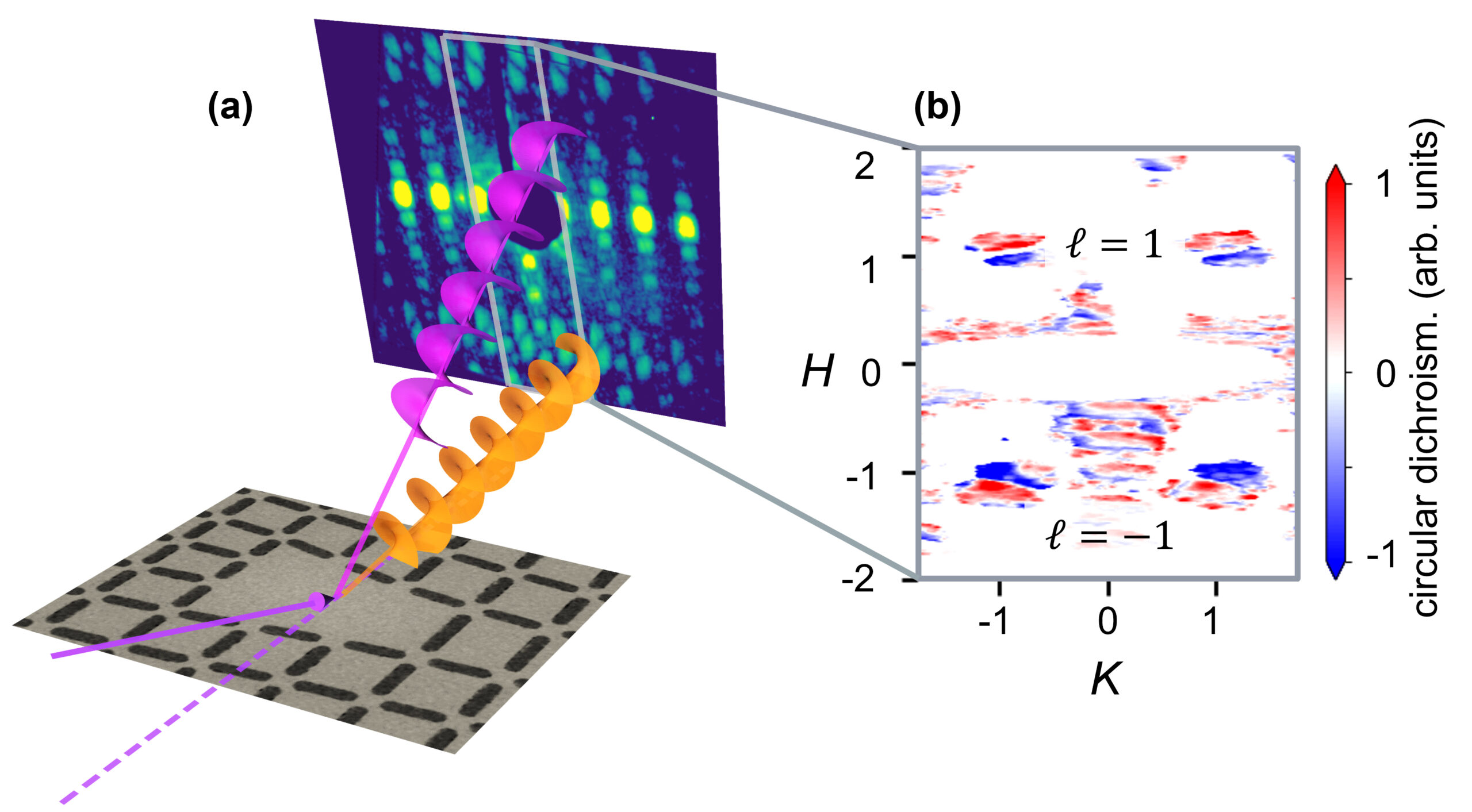SCIENTIFIC ACHIEVEMENT
Using spiraling x-ray beams generated at the Advanced Light Source (ALS), researchers differentiated between energetically equivalent (“degenerate”) states in an antiferromagnetic lattice.
SIGNIFICANCE AND IMPACT
The work shows the potential of these beams to probe properties that would otherwise be inaccessible, to better understand phenomena of fundamental interest and for applications such as spintronics.

X-ray beams with a twist
X-ray experiments are an important tool for understanding the electronic and magnetic properties of materials. The polarization (i.e., the direction of the oscillating electromagnetic field) of x-rays is often used to probe anisotropy or chirality. A property of x-rays that has yet to be utilized in experiments is their orbital angular momentum (OAM). X-rays with OAM have an azimuthally varying phase, which means the phase twists as the x-rays propagate. This leads to a gradient in the electromagnetic field, which could cause the twisted photons to have different interactions with materials.
X-rays with OAM have a helicity ℓ = ±1, which corresponds to whether the phase is twisting in the clockwise or counterclockwise direction. Similar to how polarization is used in experiments, OAM can be used to probe chirality and magnetism, and potentially more exotic properties like topology. It could also improve the resolution of x-ray imaging and microscopy techniques. In this work, researchers showed how helicity-dependent effects in resonant x-ray scattering (RXS) can be used to investigate the magnetic configuration of a lattice.
Creating twisted light

One way to create x-ray beams with OAM is by scattering from a topological defect. Here, a square lattice of permalloy nanomagnets was synthesized on a silicon substrate. Two extra nanomagnets were inserted into the center to create a topological edge defect.
At ALS Beamline 11.0.1.1, photoemission electron microscopy (PEEM) with x-ray magnetic circular dichroism (XMCD) was used to image the magnetic configuration. The results showed that the nanomagnets order antiferromagnetically, where the direction of magnetization alternates on adjacent nanomagnets.
To investigate what OAM beams can reveal about the antiferromagnetic lattice, RXS experiments were performed with circularly polarized light at ALS Beamline 7.0.1.1 (COSMIC Scattering). Scattering from the nanomagnets created beams with both positive and negative OAM helicities, and circular dichroism was used to compare beams of opposite helicity at distinct antiferromagnetic peaks.
Helicity-dependent scattering
The researchers found that the circular dichroism has a distinct pattern, which is inverted for beams of opposite helicity. Furthermore, the antiferromagnetic lattice forms in one of two degenerate ground states, and the helicity-dependent circular dichroism can be used to distinguish between them.

Since the two ground states are degenerate, they should form with equal probability if the antiferromagnet is heated and returned to room temperature. To test this, the nanomagnet array was repeatedly heated to 380 K and cooled. At room temperature, both configurations appeared with about equal probability, as expected for random thermal switching between two degenerate ground states.
This is one of the first experiments to show how the helicity of light can be used to study magnetism. Information about the real-space magnetic configuration of a lattice is usually inaccessible in such experiments, so this work demonstrates the potential of OAM beams for gaining information beyond what is typically obtained in other experiments.
Promising future avenues include using OAM beams in resonant diffraction studies of traditional antiferromagnets, in nanodiffraction studies of domain walls and defects, and, if an OAM beam can be used to measure specific spin sublattices, for directly measuring spin currents.
Contacts: Sujoy Roy and Margaret McCarter
Researchers: M.R. McCarter, A.I.U. Saleheen, A. Scholl, S.A. Morley, and S. Roy (ALS); A. Singh (Berkeley Lab); R. Tumbleson (UC Santa Cruz and ALS); J.S. Woods (Univ. of Kentucky and Argonne National Laboratory); A.S. Tremsin (UC Berkeley); and L.E. De Long and J.T. Hastings (Univ. of Kentucky).
Funding: Laboratory Directed Research and Development program (Berkeley Lab), National Science Foundation, and U.S. Department of Energy, Office of Science, Basic Energy Sciences program (DOE BES). Operation of the ALS, Molecular Foundry, and Center for Nanoscale Materials is supported by DOE BES.
Publication: M.R. McCarter, A.I.U. Saleheen, A. Singh, R. Tumbleson, J.S. Woods, A.S. Tremsin, A. Scholl, L.E. De Long, J.T. Hastings, S.A. Morley, and S. Roy, “Antiferromagnetic real-space configuration probed by dichroism in scattered x-ray beams with orbital angular momentum,” Phys. Rev. B 107, L060407 (2023), doi:10.1103/PhysRevB.107.L060407.
ALS SCIENCE HIGHLIGHT #482